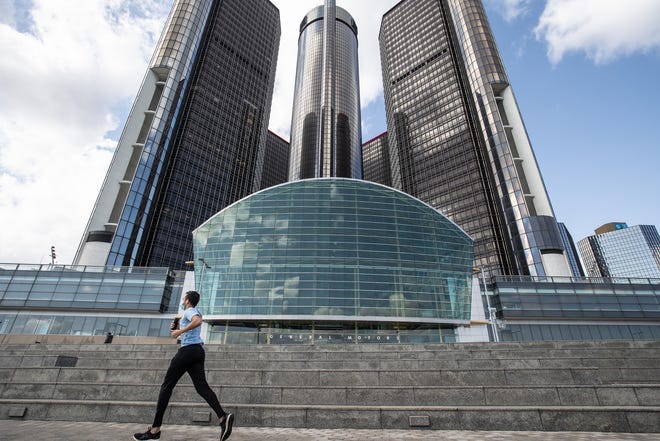General Motors’ second-quarter earnings came in about 39% lower than the year-ago period as ongoing production disruptions persisted due to supply chain issues and an industry-wide global semiconductor chip shortage.
As fears of a nationwide recession loom, GM assured Wall Street on Tuesday that it is already taking cost-cutting measures, such as dialing back on new hires, and is prepared to do more if needed.
GM reported a second-quarter net income of $1.7 billion compared with $2.8 billion in the year-ago period. GM saw continued strong demand for big pickups and large SUVs, which carry wide profit margins, and increased sales to fleet customers. As a result GM’s net revenue for the quarter rose to $35.8 billion compared with $34.2 billion a year ago.

In a letter to shareholders, CEO Mary Barra said the company’s outlook for the second half of the year is strong on the belief that new vehicle production will improve and GM will see a sharp rise in fleet orders. GM continues to expect its full-year adjusted earnings before interest and taxes to be $13 billion to $15 billion.
But, she warned, there are economic concerns that are driving GM to take some cost-cutting measures.
“We are already taking proactive steps to manage costs and cash flows, including reducing discretionary spending and limiting hiring to critical needs and positions that support growth,” Barra said. “We have also modeled many downturn scenarios and we are prepared to take deliberate action when and if necessary.”
As the Free Press first reported in May, GM put its plans on hold to hire 3,000 salaried workers this year, saying it was ahead of schedule. The automaker had already hired 7,000 salaried workers.
But in subsequent interviews, CFO Paul Jacobson said GM was scrutinizing every hire it will make going forward to be sure it is needed, in an effort to preserve cash in the face of rising raw material costs and the possible recession.
Ford Motor Co. is expected to slash jobs largely in North America in upcoming months to help pay for its EV transition. When asked Tuesday during a call with reporters whether GM has similar plans, Jacobson said, “We’re not running any scenarios now where we contemplate layoffs. But we’re going to watch the environment closely.”
Barra noted that GM has strong cash flow, an investment-grade credit rating, low pension obligations and record pricing to protect it from economic turbulence. Indeed, GM ended the quarter with $17.9 billion in automotive cash. At this time last year, GM had $17.1 billion.

GM also announced Tuesday that it inked three new supplier agreements to help secure raw materials for the 1 million electric vehicles it plans to produce by the end of 2025 as it transitions to an all electric lineup by 2035.
“Going forward, we will continue to mitigate risk and drive down costs to help us deliver $90 billion of annual EV revenue by 2030,” Barra said in the letter.
Ford Motor Co. reports its results on Wednesday and Stellantis reports its results on Thursday.
The numbers
GM said it had a second-quarter earnings before interest and taxes adjusted of $2.3 billion. That’s in line with the earnings update the company issued on July 1, but well below the $4.1 billion in the year-ago period as production improved this time last year, boosting some inventory.
In North America, GM reported its adjusted earnings before interest and taxes of $2.3 billion compared with $2.9 billion last year.
GM’s financing arm, GM Financial, reported a slight dip in net sales of loans and revenue. In the quarter, its net sales and revenue came in at $3.2 billion compared with $3.4 billion a year earlier. GM Financial reported adjust earnings before interest of $1.1 billion compared with $1.6 billion a year ago.
GM’s China reported a loss in equity income of $87 million compared with a $276 million profit a year ago.
GM gained a full percentage point in U.S. market share, ending the quarter with 16.2% of the market compared with 15.3% in the year-ago period.
“Don’t get excited about a 1 percentage point improvement in market share,” Michelle Krebs, executive analysts for Cox Automotive, told the Free Press. “It just gets GM back to where it has been the last few years.”
Last year’s second quarter was a low for GM at 15.5%, the only time it was below 16% since at least2017, Krebs said. The big difference this year was an improvement in Chevrolet sales, she said.
Analysts say supply-chain problems are what especially have plagued the automaker.
“Until the second quarter, GM had managed to buoy profits on higher revenue, driven by increased vehicle prices and lower incentive spending,” Krebs said. “However, supply chain issues, notably the computer chip shortage, caught up with GM in the quarter as it could not keep those profits up, missing Wall Street estimates.”
She said the COVID-19 pandemic lockdowns in China hurt GM in the quarter.
“And Buick in the U.S. didn’t help,” said Krebs. “For the second consecutive quarter, its sales were down significantly.”
GM’s watching the signs
GM does not see an economic slowdown in the near term, but Jacobson told reporters the automaker is closely monitoring the economy for any signs of a recession.
“I don’t like to get into the game of predicting. We’re watching a lot of data points around the consumer,” Jacobson said. “All indicators are still pointing at a lot of strength in customers … but we’ll watch it and act if we see headwinds persist.”
In 2018, Jacobson said GM took steps to reorganize to get costs down by $4 billion to $4.5 billion to position the company for its transformation to an all-electric carmaker by 2035. Those cost cuts included eliminating about 4,000 salaried jobs in 2019.
Since that time, GM has added some 14,000 white collar jobs, largely in roles to support EVs and to grow GM’s self-driving subsidiary, Cruise, in San Francisco. Cruise recently became one of the first companies to collect fares for driverless ride hailing services. But it remains unprofitable. In the quarter, Cruise incurred losses of $543 million, greater than the losses it saw a year ago of $332 million.
GM has said it will spend about $2 billion on Cruise this year as Cruise launches a self-driving taxi fleet in San Francisco. In October 2021, at GM’s Investor Day, then-Cruise CEO Dan Ammann said the target for the ride-hailing business was to reach $50 billion in revenue as it ramps up operations over the next eight years.
“In the last 18 months, we’ve remained focused on those (EV) goals despite a lot of distractions,” Jacobson said. “We’re not seeing anything that indicates any near-term issues. We will be very agile and nimble — we’ve slowed down some hiring and managing spending and costs.”
GM and LG Energy Solution will start making batteries at their joint venture Ultium Cells LLC in Lordstown, Ohio, in about three weeks. Jacobson said that will help GM “significantly increase” its EV production to help it reach 1 million in North America by the end of 2025.
Parked and waiting
In the U.S., GM’s largest market, GM sold 29,000 Buicks in the quarter compared with 66,000 a year ago.
Earlier this month, GM reported new car sales in the quarter were down 15.4% from the year-ago period. It sold 582,401 vehicles compared with 688,236 a year earlier. GM’s sales to commercial, government and rental fleets rose by 29% supported by increased supply of vehicles such as the GMC Savana van, which reported a gain of 25% to 6,803 sold.
GM reported at the end of June that it had manufactured 95,000 vehicles without certain components, notably computer chips, Krebs said. The vehicles remained parked awaiting arrival of the parts for installation, hopefully by the end of the year.
“Robust demand allowed GM to cut incentives by 61% while its average transaction price edged higher,” said Krebs, adding that GM’s overall average transaction price rose 5% to $50,261, according to Cox Automotive calculations.
GM has warned Wall Street that supply chain disruptions will delay delivery of those 95,000 vehicles to dealers into the second half of the year.
Jacobson told reporters Tuesday that the automaker expects to deliver those vehicles to dealers by the end of the year.
“We’re making tremendous progress already in the month of July,” he said.
More:GM CEO Mary Barra’s rare, behind-the-scenes interview: Who she relies on in ‘lonely job’
More:GM joint venture gets $2.5 billion government loan to help build EV battery cell plants
Contact Jamie L. LaReau at jlareau@freepress.com. Follow her on Twitter @jlareauan. Read more on General Motors and sign up for our autos newsletter. Become a subscriber.